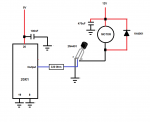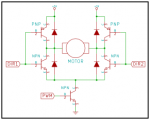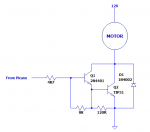Happy Holidays!
Been playing around with transistor and the 28x1.
Followed manual or interfacing both!
Sucessfully worked lighting leds!
But soon realized It works as a switch.
Now after doing research find out this transistor are current driven!!
So, Got me couple of 2N4401 transistors (NPN) 600 mA max current.
Got the datasheet and got all info but I will like to understand it a little better.
How do I get the Base transistor Value? Using 5v at the base, 12v at collector, Load is 30 ohms , 400mA current 4.8 watt motor.
How do I get the proper hFE, Vce & Vbe from data sheet?
My math come up to 944 ohms.
Is that correct?
Been playing around with transistor and the 28x1.
Followed manual or interfacing both!
Sucessfully worked lighting leds!
But soon realized It works as a switch.
Now after doing research find out this transistor are current driven!!
So, Got me couple of 2N4401 transistors (NPN) 600 mA max current.
Got the datasheet and got all info but I will like to understand it a little better.
How do I get the Base transistor Value? Using 5v at the base, 12v at collector, Load is 30 ohms , 400mA current 4.8 watt motor.
How do I get the proper hFE, Vce & Vbe from data sheet?
My math come up to 944 ohms.
Is that correct?



